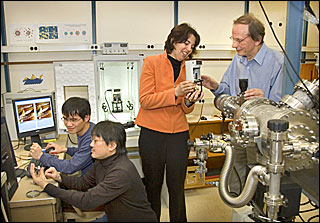Brookhaven Lab Scientists Discover Gold Clusters Stabilize Platinum Electrocatalysts For Use in Fuel Cells
January 11, 2007
UPTON, NY - Platinum is the most efficient electrocatalyst for accelerating chemical reactions in fuel cells for electric vehicles. In reactions during the stop-and-go driving of an electric car, however, the platinum dissolves, which reduces its efficiency as a catalyst. This is a major impediment for vehicle-application of fuel cells.
 enlarge
enlarge
(Clockwise) Brookhaven Lab researchers Kotaro Sasaki, Junliang Zhang, Eli Sutter and Radoslav Adzic view gold clusters on a single-crystal platinum surface using a scanning tunneling microscope. (Click image to download hi-res version.)
Now, scientists at the U.S. Department of Energy's Brookhaven National Laboratory have overcome this problem. Under lab conditions that imitate the environment of a fuel cell, the researchers added gold clusters to the platinum electrocatalyst, which kept it intact during an accelerated stability test. This test is conducted under conditions similar to those encountered in stop-and-go driving in an electric car. The research is reported in the January 12, 2007, edition of the journal Science.
Brookhaven's Chemistry Department researchers Junliang Zhang, Kotaro Sasaki, and Radoslav Adzic, along with Eli Sutter from Brookhaven's Center for Functional Nanomaterials, authored the research paper. "Fuel cells are expected to become a major source of clean energy, with particularly important applications in transportation," said coauthor Radoslav Adzic. "Despite many advances, however, existing fuel-cell technology still has drawbacks, including loss of platinum cathode electrocatalysts, which can be as much as 45 percent over five days, as shown in our accelerated stability test under potential cycling conditions. Using a new technique that we developed to deposit gold atoms on platinum, our team was able to show promise in helping to resolve this problem. The next step is to duplicate results in real fuel cells."
A hydrogen-oxygen fuel cell converts hydrogen and oxygen into water and, as part of the process, produces electricity. Platinum electrocatalysts speed up oxidation and reduction reactions. Hydrogen is oxidized when electrons are released and hydrogen ions are formed; the released electrons supply current for an electric motor. Oxygen is reduced by gaining electrons, and in reaction with hydrogen ions, water, the only byproduct of a fuel cell reaction, is produced.
In the unique method developed at Brookhaven, the researchers displaced a single layer of copper with gold on carbon-supported platinum nanoparticles. After being subjected to several sweeps of 1.2 volts, the gold monolayer transformed into three-dimensional clusters. Using x-rays as probes at Brookhaven's National Synchrotron Light Source, a scanning transmission microscope at Brookhaven's Center for Functional Nanomaterials, and electrochemical techniques in the laboratory, the scientists were able to verify the reduced oxidation of platinum and to determine the structure of the resulting platinum electrocatalyst with gold clusters, which helped them to gain an understanding of the effects of the gold clusters.
In the Brookhaven experiment, the platinum electrocatalyst remained stable with potential cycling between 0.6 and 1.1 volts in over 30,000 oxidation-reduction cycles, imitating the conditions of stop-and-go driving. "The gold clusters protected the platinum from being oxidized," Adzic said. "Our team's research raises promising possibilities for synthesizing improved platinum-based catalysts and for stabilizing platinum and platinum-group metals under cycling oxidation/reduction conditions."
This research is funded through the U.S. Department of Energy's Hydrogen Program, which implements the President's Hydrogen Fuel Initiative, a five-year program that began in 2003 to sponsor research, development, and demonstration of hydrogen and fuel cell technologies. Specifically, the funding derived from DOE's Office of Basic Energy Sciences and its Office of Energy Efficiency and Renewable Energy.
2007-10577 | INT/EXT | Newsroom









